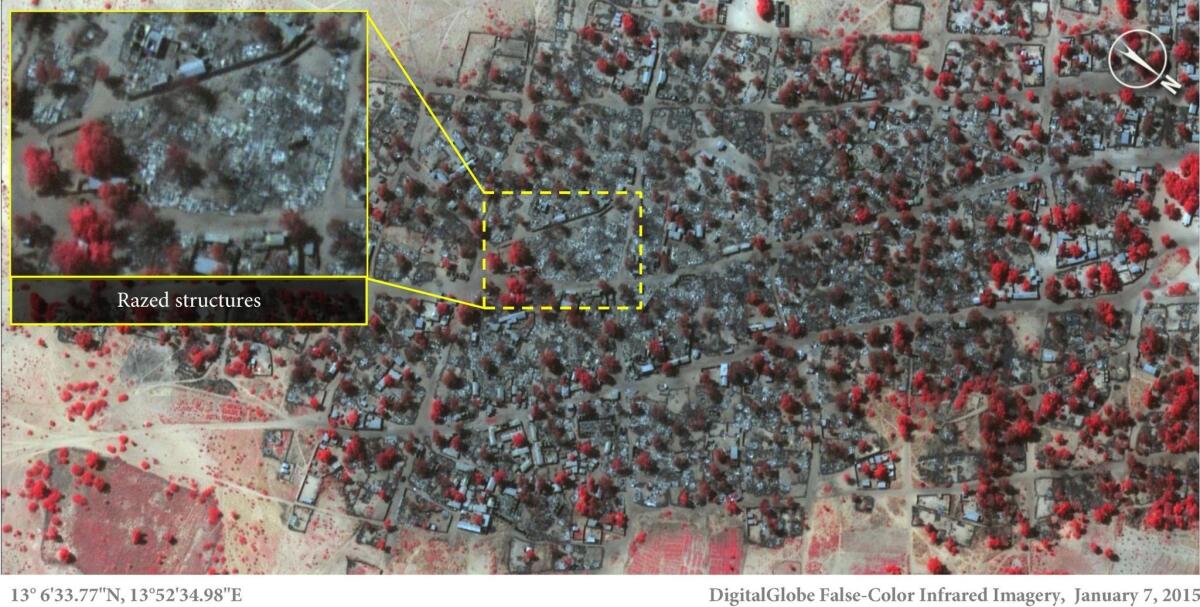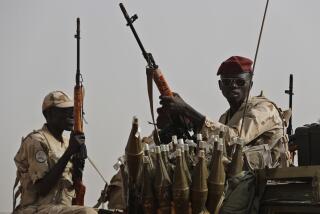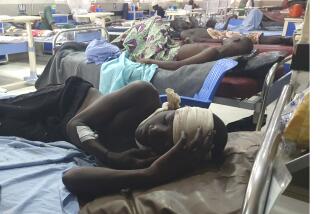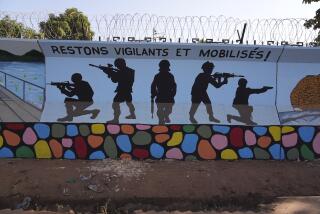In Nigeria, satellite images shed light on Boko Haram’s rampage

Reporting from Johannesburg, South Africa — A photograph from the sky depicts a typical African town: tin roofs, lush trees and dusty roads. In the next satellite image, taken a few days later, the same town is just a gray blur, the ash and ruins left by the militant group Boko Haram, which rampaged through the far northeast of Nigeria this month.
That something terrible had happened in the town of Baga and the surrounding area had been known shortly after the attacks began Jan. 3. But Nigerian authorities threw the seriousness of the devastation into doubt this week, insisting that 150 people died, including many of the assailants, in contrast with unconfirmed reports that as many as 2,000 people had been killed.
The chilling satellite images, released by human rights groups Amnesty International and Human Rights Watch, brought rare clarity to a conflict that is often murky and difficult to assess. The damage in Baga and the almost total destruction of nearby Doron Baga threw the activities of Boko Haram, one of the world’s most ruthless Islamist militant groups, into sharp relief.
News of its atrocities in northeastern Nigeria often emerges in trickles, partly because it controls a huge swath of territory where roads are extremely dangerous, it has blown up cellphone towers, and fleeing witnesses don’t have time to estimate the number of dead.
In Baga, survivors described piles of bodies, people being killed “like insects” and small children among the victims. Some witnesses said they ran over dozens of bodies as they fled. Others said people were dragged from their houses by the militants and shot.
The recent attacks, during which Boko Haram took control of 16 towns and villages and drove Nigerian soldiers from a military base, follow the deadliest year in the insurgency. About 10,000 people are believed to have been killed in 2014, according to the Council on Foreign Relations, out of more than 16,000 killed since 2011.
The militant group is bitterly opposed to Western culture, including secular education, democracy, taxes and banking. It routinely blows up bank ATMs and cellphone towers, and raids school dormitories at night, shooting schoolboys in their beds or locking them in and firebombing the buildings, slitting the throats of those who manage to get out.
In another chilling Baga attack in November, the militants ambushed 48 fishermen and quietly cut their throats, so as not to alert soldiers in the nearby military base. Those who didn’t die were trussed up and tossed into the waters of Lake Chad, where they drowned.
Boko Haram has kidnapped hundreds of women and girls, including 276 schoolgirls from Chibok town in April. The group’s leader, Abubakar Shekau, boasted that they had been sold off as “slaves.”
A series of horrifying suicide bombings by girls in recent months has raised fears the group may be using its captives to carry out the attacks.
Boko Haram began its insurgency just over a decade ago, seeking to impose a strict version of sharia, or Islamic law, in the north. The group stepped up its attacks in the northeast last year, seizing a vast area as it swept into villages and towns, gunning down traders at crowded markets and burning down houses and shops.
The areas worst hit were those that set up local defense units, known as the Civilian Joint Task Force. Many of the defense unit vigilantes are determined to defend their towns and villages, but are armed with only old hunting guns, spears and machetes.
Boko Haram also launched bombing attacks in towns and cities as far south as the capital, Abuja, killing dozens at a time, often poor market traders or people in crowded bus stations. Last year it declared its territory a caliphate, following the example of the militant group Islamic State.
The Baga attack is not the first of its kind. In May, Boko Haram gunmen disguised as soldiers launched a devastating attack on the town of Gamboru Ngala, opening fire and burning houses in a daylong rampage, according to witnesses interviewed by The Times. Town authorities said they counted 315 bodies there after the assailants left. About 200 people from nearby villages were killed. There too, little was left.
“Initially, people were being killed in ones and twos. Now they’re being killed in the hundreds,” said Ali Malallam, 32, a cellphone repairman who was in the market when the Gamboru Ngala attack occurred. “It’s infuriating that people are being killed like chickens and the government doesn’t seem to care.”
Malallam was interviewed on his cellphone, using a number from neighboring Cameroon because of the destruction of many cellphone towers in northeastern Nigeria.
Critics say Nigeria’s military has failed to engage Boko Haram head-on, failing to protect towns and villages and ceding a vast area to the militant group.
Amnesty International spokesman Daniel Eyre said the satellite images of the attack around Baga showed “catastrophic” destruction.
“Of all Boko Haram assaults analyzed by Amnesty International, this is the largest and most destructive yet,” Eyre said Thursday. “It represents a deliberate attack on civilians whose homes, clinics and schools are now burnt-out ruins.”
“Up until now, the isolation of the Baga combined with the fact that Boko Haram remains in control of the area has meant that it has been very difficult to verify what happened there,” Eyre said. “Residents have not been able to return to bury the dead, let alone count their number. But through these satellite images combined with graphic testimonies, a picture of what is likely to be Boko Haram’s deadliest attack ever is becoming clearer.”
Eyre said the satellite images raised doubt about the Nigerian Defense Ministry’s estimate of 150 dead.
“These images, together with the stories of those who survived the attack, suggest that the final death toll could be much higher than this figure,” he said.
The United Nations says more than 7,000 people fled into neighboring Chad and Niger.
Both towns shown in the images are near Lake Chad, where residents used to catch and trade fish until the militants’ attacks on roads made the business impossible last year. Attacks by Boko Haram have ruined the northern economy, with farmers fleeing their land and traders unable to transport goods because of hijackings, thefts and killings.
Survivors of the Baga area attacks described seeing hundreds of bodies, according to Amnesty International.
“They killed so many people. I saw maybe around 100 killed at that time in Baga,” one man told Amnesty International. “I ran to the bush. As we were running, they were shooting and killing.”
“I don’t know how many but there were bodies everywhere we looked,” a woman who survived told the rights group.
Another witness told the organization the killers fired indiscriminately, killing small children and a woman who was delivering a baby. The gunmen also rounded up women and girls, adding to their growing list of prisoners.
Follow @robyndixon_LAT on Twitter for news out of Africa
More to Read
Sign up for Essential California
The most important California stories and recommendations in your inbox every morning.
You may occasionally receive promotional content from the Los Angeles Times.










